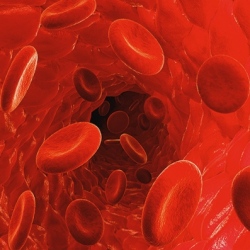
A cancer detection technique has been developed by scientists at Stanford University. The process involves a small magnetic wire being inserted into a vein where it attracts free-floating tumor cells in the blood, which could prove an effective way to catch the disease much earlier than current blood-based detection methods.
Many researchers are tirelessly working to find new and effective ways to detect the presence of cancer using a simple blood test. Several promising novel blood tests are in development, tracking a variety of biomarkers that may indicate the presence of cancer. But ideally, actually tracking free-floating tumor cells circulating in a person’s bloodstream would be the best way to detect the disease. Unfortunately, these tumor cells are just too scarce to be effectively caught and identified in single blood samples.
"These circulating tumor cells are so few that if you just take a regular blood sample, those test tubes likely won’t even have a single circulating tumor cell in them," says Sam Gambhir, senior author on the new study. Gambhir describes trying to locate these circulating tumor cells from a small blood sample as akin to finding a grain of sand in a bathtub by scooping out a single cup of water.
The innovative new method instead uses a tiny magnetic wire inserted into a vein to attract the tumor cells. In order to magnetize these free floating tumor cells the researchers engineered nanoparticles with an antibody that homes in on the desired tumor cells. These nanoparticles act as tiny magnets, so once they latch onto the free-floating tumor cells it is only a matter of time before they float past the magnetized wire and stick to it.
The method has been effectively tested so far in pigs and it identified 10 to 80 times more tumor cells than current blood-based detection methods. The amount of time the wire is left in a patient was found to determine the overall volume of blood that has been effectively examined.
"We estimate that it would take about 80 tubes of blood to match what the wire is able to sample in 20 minutes," says Gambhir.
The method has not yet been tested in humans but the Stanford team is working towards human trials. Current toxicity tests in mice are suggesting the injected nanoparticles should be safe and mostly decay over a few weeks after administration.
The team is also considering whether the technique could be used as a possible treatment as well as a simple detection technique. Gambhir hypothesizes that if it proves to be an effective tool to suck up free-floating tumor cells, then it could be potentially left in for longer periods of time to act as a kind of filter that prevents the cancer from spreading through to bloodstream to other parts of the body.
The method may also be useful for a broad variety of different applications. In theory, the technique can be modified to target other cell types, molecules or biomarkers that circulate in the blood, making it a more useful detection system than small individual blood tests.
"For example, let’s say you’re checking for a bacterial infection, circulating tumor DNA or rare cells that are responsible for inflammation – in any of these scenarios, the wire and nanoparticles help to enrich the signal, and therefore detect the disease or infection," says Gambhir.
